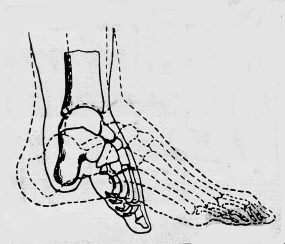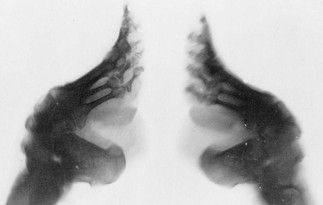Lotus what? Restrictive Shoes vs Healthy Feet
- Vitória

- Nov 4, 2023
- 4 min read
Updated: Jan 9
A short dive into a practice that deformed women's feet for centuries and its parallels with mainstream shoes. Served with a healthy dose of anatomy and reflection.

Photo by cheng feng on Unsplash
Table of Contents
Lotus feet: quick 'recap' of the practice of foot binding in China
Foot binding was the process of breaking and binding women's feet, starting when they were young girls and continuing throughout their lives. The practice dates to the 10th century and carried on for over a thousand years. All toes except the largest were broken, folded under the sole of the foot and tightly bound with cotton or silk bandages. The feet were cleaned every few days and the wrapping tied increasingly tighter each time.
Foot binding was seen as an indication of nobility and beauty. Small feet were idealized in ancient China, they were considered the peak of femininity and desirability. The reality of foot binding is quite the opposite, it was a cruel, brutal practice. Girls and women with bound feet endured unimaginable pain throughout their lives. Some sources say foot binding was used to keep young girls disciplined. It was a way to make women more appealing and young girls were coerced to tolerate this practice based on the promise that having small lotus feet would help them find a - higher class - husband.
Foot binding prevented little girls from having a normal, playful childhood. They had difficulty moving around due to the pain of having their feet bound. In pain, rendered unusable, the body permanently trying to heal wounds that would be repeatedly inflicted upon it again and again. Unable to walk without pain, run or do sports, these young girls grew into women with jobs that allowed them to use their hands and sit all day.
Then and now: body restriction parallels
Let's be honest, us humans have a pretty bad rep for damaging practices like foot binding, corsets, elongated necks: and impractical footwear like Poulaine shoes or long pointed Mexican boots. We do have something for every taste. But we must ask questions: are these trends enhancing or prohibitive? Is it okay to mass commercialize shoes that cause foot deformation and body damage? Is it ethical to put children in restrictive shoes that prohibit their natural development?
I cannot help seeing a parallel between the old, now illegal practice of foot binding, and "modern" shoes. The claim to innovation made by the aesthetics of mainstream shoes, defeats functionality by far, thus, culminating in the opposite of innovation. A shoe purchase can sometimes even be driven by our natural desire to be accepted, unfortunately manifesting in a need to show off or attain a certain social status. Mainstream "fancy, cool, stylish" shoes are still very much bound (pardon the pun) to old-fashioned trends (and some very silly trends) which disregard optimal function and health.
The healthy human foot
The anatomy of the human foot is really something. It has 26 bones, 33 joints and over a 100 tendons, muscles and ligaments. Plus, the foot has over 200 000 nerve endings which transmit sensory information to our brain. Why would our feet be so exquisitely built if we didn't need it to be so? The human foot is a powerhouse of potential: strength, stability, flexibility and sensory feedback. Why should we inhibit all that?
Surely the human foot evolved this way for a reason. 40 000 years ago we started making shoes to protect us from the elements and although we still need that protection, I think we need to be connected now, more than ever. Most “normal” shoes are heeled shoes - not just for women, for everyone. Men's dressy shoes have heels too, and heels take away our spring power. Modern shoes are weakening our feet's bones, tendons, muscles and arches, hurting our toes and causing damage in our kinetic chain, from the ground up.
Modern shoes are disconnecting us from the ground and by that same token, disconnecting us from our full potential. Think about it: we use our hands with their full potential - we grab things, we feel textures, we even climb. Yet we squeeze our feet, for decades of our lives, into non-foot-shaped shoes, not allowing them to reach their full potential to serve us as they can. I have not yet seen a bad argument for foot-shaped shoes. If hands deserve cozy gloves, so do feet. Do not impair your muscles or your senses, consider what is important to you, and if health matters to you, then consider barefoot shoes. If you are interested in foot freedom in warmer weather, check this post where I guide you through the making of an excellent pair of DIY sandals.
Advertisement:
Resources
If I would include all the fascinating details I found in my research, this article could be a book, so I want to leave you some (re)sources below. If you want to learn more, see this page. Knowledge is power - enjoy!
History
The Strange Practice of Chinese Foot Binding (more text) - The Internet Says it's True
Bound to be beautiful: The bizarre practice of foot-binding was once a symbol of beauty in China (more images) - The Vintage News
Small Feet of the Chinese Females - Encyclopedia.com
Shoes Timeline (cool, interactive) - Victoria and Albert Museum, London
Why Were Medieval Europeans So Obsessed With Long, Pointy Shoes? - Atlas Obscura
Why are we wearing corsets on our feet? - Ahinsa shoes
History of Footwear (more text) - Shoe Adviser
History of Footwear (more images) - All that's interesting
Anatomy of the foot
The sensory role of the sole of the foot: Review and update on clinical perspectives - ScienceDirect
Foot Anatomy - Biology Dictionary
The Nerves of the Leg and Foot (3D model and text) - Innerbody Research
Nerve endings in your feet - FeelYourFeet
Barefoot shoes
Benefits of Barefoot Shoes | The Problem with Modern Shoes - informative video, under 5 minutes
Shoespiracy - short documentary, under 5 minutes
Shoespiracy (Extended cut) - short documentary, under 9 minutes





























Comments